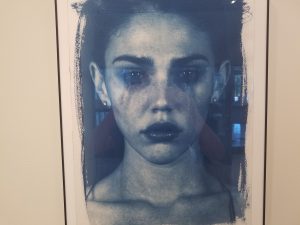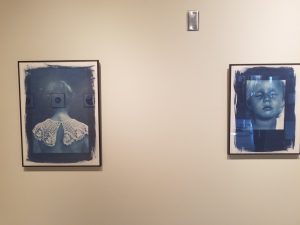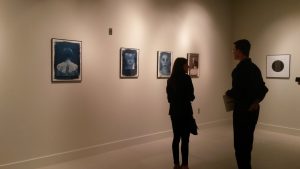The art gallery housed in the Visual Arts Center has been a part of campus life for years. It hosts senior and junior art seminars and artwork from established regional artists. On Sept. 29, the gallery will be hosting the Patricia Wier Mynka Memorial Exhibition, in honor of Patricia Mynka, who graduated from the school and willed $25,000 to Blackburn College. The event, traditionally held during homecoming, has been a part of Blackburn for years and seeks to showcase successful alum, but the gallery isn’t all tradition. For the first time since 2008, it’s back in professor of fine art Robert Huber’s hands, and he’s making some changes.

Artwork by Giada Otten inside the Visual Arts Center Gallery
The first and the most important change is consistency. In the past, the gallery was sometimes found empty, and shows could be poorly advertised. Huber said, “I want to have a regular schedule that’s pre-planned a year in advance.” The goal is for art to always be showing in the gallery and to try to match opening dates with important events on campus. The consistency enables the department to advertise better and plan ahead, and also makes the school more attractive to visiting artists. It is important that Blackburn be attractive to potential artists because much information regarding who Blackburn hosts comes through word of mouth, and if artists have good openings and enjoy visiting, they will tell others. But the gallery is important for more than just art students or artists. According to Huber, the gallery is a place where students can interact with the wider world. “This is a way to see things that are happening in metropolitan areas all around the region,” he said. “People really should take advantage of it.”

Artwork by Giada Otten inside the Visual Arts Center Gallery
The upcoming Memorial Exhibition will feature photographs by Jon Randolph, who graduated from Blackburn in 1970, and Richard Sitler, who graduated in 1990. Both of the choices showcase Huber’s dedication to making the gallery a space where students can experience the world outside of this small campus. “Richard has traveled a lot overseas and to Latin America…his work really speaks to diversity. It’s a broad, sort of international body of work. It has sort of a humanitarian edge to it,” said Huber. As for Randolph, who is also a photographer, Huber found that his work was a great compliment to Sitler’s and said, “It was a similar vein, just a different aesthetic.”

The first show this year, an exhibition for Giada Otten, opened to great success and turnout. “The most important thing was that Giada was happy…we made some other good connections,” Huber said. Nevertheless, he acknowledged that there were roadblocks to keeping the gallery filled, not the least of which was budgeting. “We need a separate budget for the gallery. We’re running on supply money to pay for the gallery,” he said. Worse yet, it’s inconsistent with how other galleries handle budgets. “The gallery needs to be sold a little bit better. We need to articulate the importance of the gallery in terms of regional identity.”
The gallery, he claims, is essential not only to art majors, but the campus identity at large. “If we’re not filling the gallery,” Huber said, “it would be negligent.”

